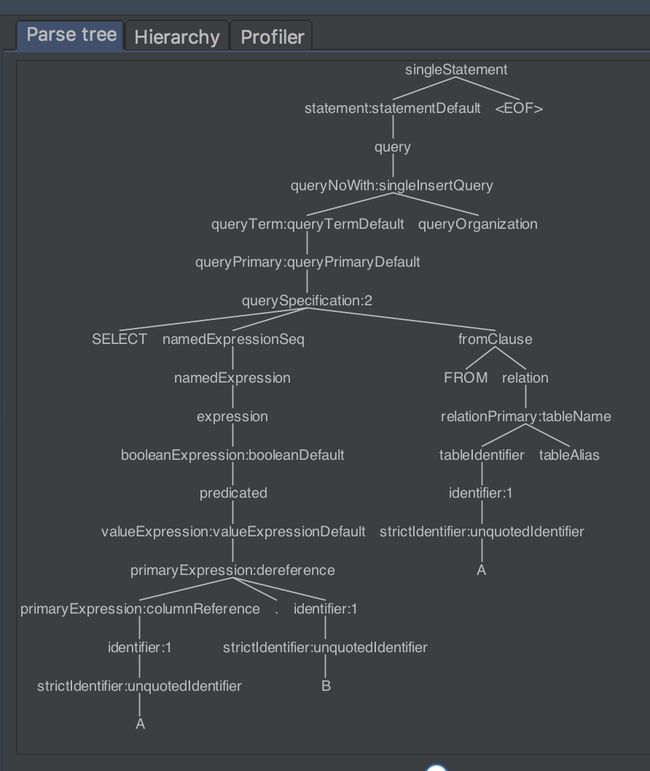spark sql 2.3 源码解读 - antlr4 && SparkSqlParser (2.3)
接着上一节,继续讲。还是以 SELECT A.B FROM A 为例。
查看AstBuilder逻辑,遍历访问,最终会访问到querySpecification节点:
override def visitQuerySpecification(
ctx: QuerySpecificationContext): LogicalPlan = withOrigin(ctx) {
val from = OneRowRelation().optional(ctx.fromClause) {
visitFromClause(ctx.fromClause)
}
withQuerySpecification(ctx, from)
}
optional用的比较多,放一下它的逻辑,其实很简单:
/**
* Create a plan using the block of code when the given context exists. Otherwise return the
* original plan.
*/
def optional(ctx: AnyRef)(f: => LogicalPlan): LogicalPlan = {
if (ctx != null) {
f
} else {
plan
}
}
/**
* Map a [[LogicalPlan]] to another [[LogicalPlan]] if the passed context exists using the
* passed function. The original plan is returned when the context does not exist.
*/
def optionalMap[C](ctx: C)(f: (C, LogicalPlan) => LogicalPlan): LogicalPlan = {
if (ctx != null) {
f(ctx, plan)
} else {
plan
}
}
FROM 语句解析,因为有join的情况,所以写的比较复杂,我们的sql比较简单,就是返回一个relation
/**
* Create a logical plan for a given 'FROM' clause. Note that we support multiple (comma
* separated) relations here, these get converted into a single plan by condition-less inner join.
*/
override def visitFromClause(ctx: FromClauseContext): LogicalPlan = withOrigin(ctx) {
val from = ctx.relation.asScala.foldLeft(null: LogicalPlan) { (left, relation) =>
val right = plan(relation.relationPrimary)
val join = right.optionalMap(left)(Join(_, _, Inner, None))
withJoinRelations(join, relation)
}
ctx.lateralView.asScala.foldLeft(from)(withGenerate)
}
对WHERE 等语句解析,有些逻辑还是很复杂,我们只需要关注自己的sql:
/**
* Add a query specification to a logical plan. The query specification is the core of the logical
* plan, this is where sourcing (FROM clause), transforming (SELECT TRANSFORM/MAP/REDUCE),
* projection (SELECT), aggregation (GROUP BY ... HAVING ...) and filtering (WHERE) takes place.
*
* Note that query hints are ignored (both by the parser and the builder).
*/
private def withQuerySpecification(
ctx: QuerySpecificationContext,
relation: LogicalPlan): LogicalPlan = withOrigin(ctx) {
import ctx._
// WHERE
def filter(ctx: BooleanExpressionContext, plan: LogicalPlan): LogicalPlan = {
Filter(expression(ctx), plan)
}
// Expressions. 也就是要查询的内容
val expressions = Option(namedExpressionSeq).toSeq
.flatMap(_.namedExpression.asScala)
.map(typedVisit[Expression])
// Create either a transform or a regular query.
val specType = Option(kind).map(_.getType).getOrElse(SqlBaseParser.SELECT)
specType match {
case SqlBaseParser.MAP | SqlBaseParser.REDUCE | SqlBaseParser.TRANSFORM =>
// Transform
// Add where.
val withFilter = relation.optionalMap(where)(filter)
// Create the attributes.
val (attributes, schemaLess) = if (colTypeList != null) {
// Typed return columns.
(createSchema(colTypeList).toAttributes, false)
} else if (identifierSeq != null) {
// Untyped return columns.
val attrs = visitIdentifierSeq(identifierSeq).map { name =>
AttributeReference(name, StringType, nullable = true)()
}
(attrs, false)
} else {
(Seq(AttributeReference("key", StringType)(),
AttributeReference("value", StringType)()), true)
}
// Create the transform.
ScriptTransformation(
expressions,
string(script),
attributes,
withFilter,
withScriptIOSchema(
ctx, inRowFormat, recordWriter, outRowFormat, recordReader, schemaLess))
// 我们的是select语句
case SqlBaseParser.SELECT =>
// Regular select
// Add lateral views.
val withLateralView = ctx.lateralView.asScala.foldLeft(relation)(withGenerate)
// Add where.
val withFilter = withLateralView.optionalMap(where)(filter)
// Add aggregation or a project.
val namedExpressions = expressions.map {
case e: NamedExpression => e
case e: Expression => UnresolvedAlias(e)
}
val withProject = if (aggregation != null) {
withAggregation(aggregation, namedExpressions, withFilter)
} else if (namedExpressions.nonEmpty) {
// 我们的sql语句的返回结果
Project(namedExpressions, withFilter)
} else {
withFilter
}
// Having
val withHaving = withProject.optional(having) {
// Note that we add a cast to non-predicate expressions. If the expression itself is
// already boolean, the optimizer will get rid of the unnecessary cast.
val predicate = expression(having) match {
case p: Predicate => p
case e => Cast(e, BooleanType)
}
Filter(predicate, withProject)
}
// Distinct
val withDistinct = if (setQuantifier() != null && setQuantifier().DISTINCT() != null) {
Distinct(withHaving)
} else {
withHaving
}
// Window
val withWindow = withDistinct.optionalMap(windows)(withWindows)
// Hint
hints.asScala.foldRight(withWindow)(withHints)
}
}
最终返回的是 Project(namedExpressions, withFilter),他继承了LogicalPlan
case class Project(projectList: Seq[NamedExpression], child: LogicalPlan) extends UnaryNode {
override def output: Seq[Attribute] = projectList.map(_.toAttribute)
override def maxRows: Option[Long] = child.maxRows
override lazy val resolved: Boolean = {
val hasSpecialExpressions = projectList.exists ( _.collect {
case agg: AggregateExpression => agg
case generator: Generator => generator
case window: WindowExpression => window
}.nonEmpty
)
!expressions.exists(!_.resolved) && childrenResolved && !hasSpecialExpressions
}
override def validConstraints: Set[Expression] =
child.constraints.union(getAliasedConstraints(projectList))
}
我们断点调试一下,结果确实是这样:
从上面我们也已经看到了LogicalPlan是Tree,每一个节点都继承自TreeNode. Spark Sql 的LogicalPlan、Expression、PhysicalPlan全都是用Tree表示的,后面都会讲到。
这次提到的LogicalPlan有三个子类:
- UnaryNode 一元节点,即只有一个子节点。如 Limit、Filter 操作
- BinaryNode 二元节点,即有左右子节点的二叉节点。如 Join、Union 操作
- LeafNode 叶子节点,没有子节点的节点。主要用户命令类操作,如SetCommand.
sql语句经过解析,得到上面三种节点构成的Tree,用于后续流程。

